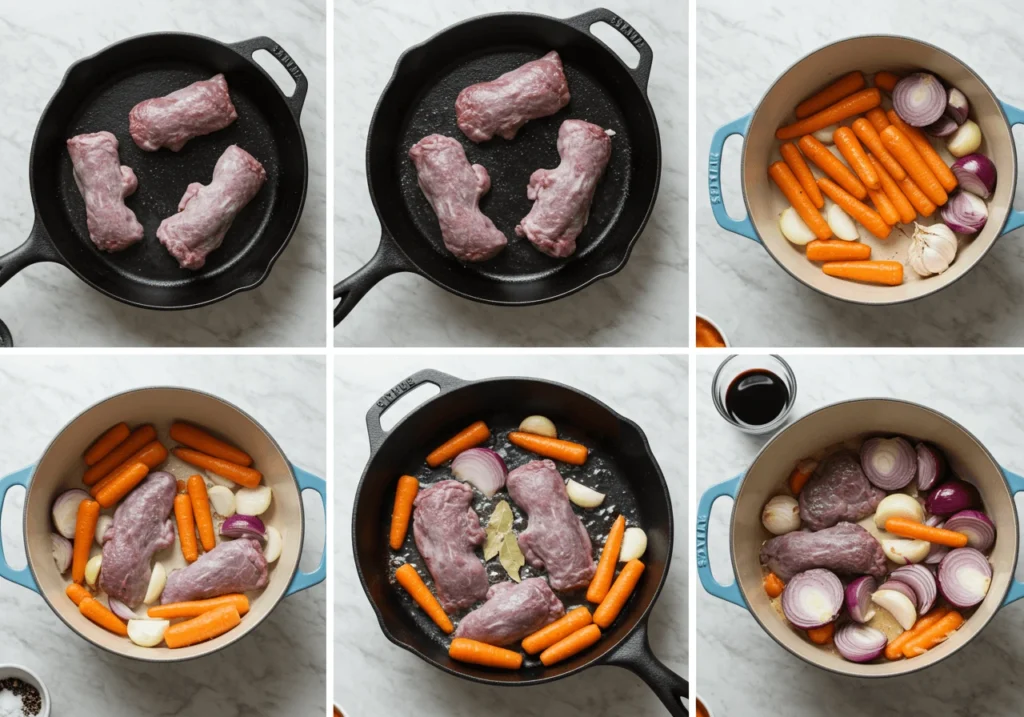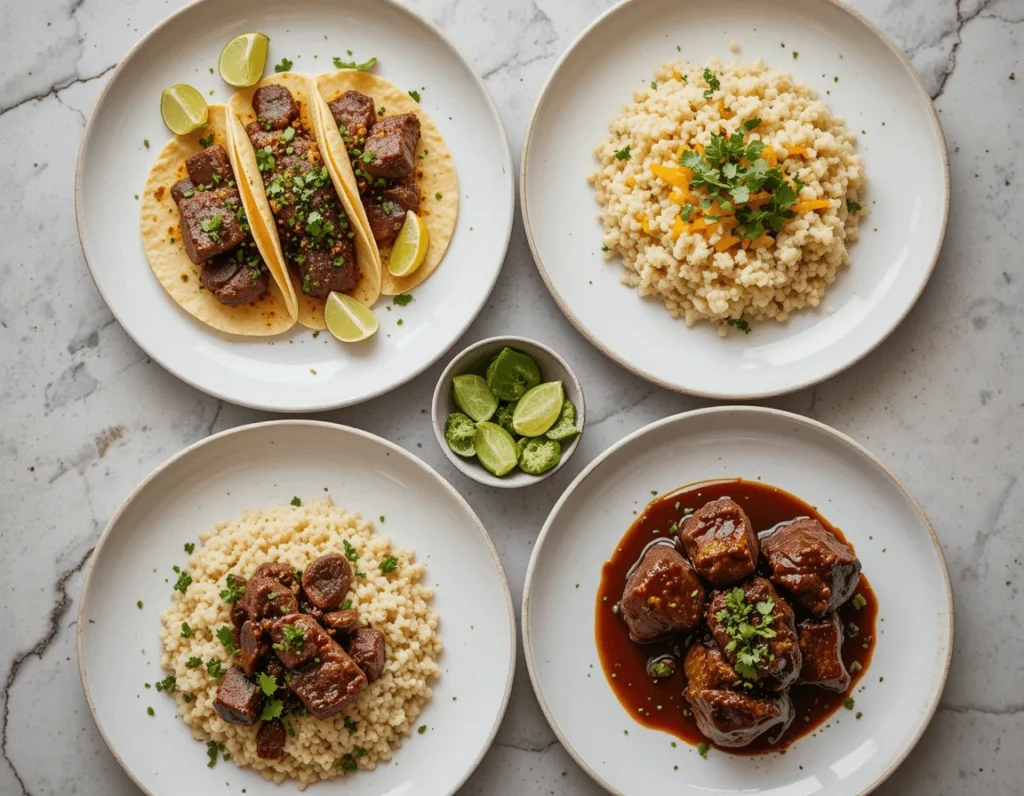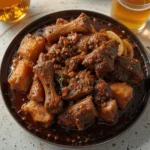If you’ve never tried beef cheek meat, you’re missing out on one of the most underrated and richly flavorful cuts of beef. Known for its melt-in-your-mouth texture when cooked low and slow, this humble cut is making a big comeback in gourmet kitchens and home cooking circles alike.
In this comprehensive guide, we’ll explore everything about beef cheeks—from what they are, how to cook them, where to buy them, to delicious recipe ideas that make the most of this collagen-rich delicacy.
Table of Contents
What Is Beef Cheek Meat?
Beef cheeks are exactly what they sound like—the facial muscle of the cow. Because cows chew constantly, these muscles are well-developed and packed with connective tissue and collagen. This gives beef cheek meat its signature dense texture and deep beefy flavor.
Unlike tender cuts like filet mignon, this is a cut that requires time and moist heat cooking methods to unlock its full potential. But once you do, the reward is unbelievable tenderness and richness.
Why It’s a Favorite in Slow Cooking
The high collagen content in beef cheeks makes them ideal for slow braising. When cooked over low heat for hours, the collagen breaks down into gelatin, creating that luscious, velvety texture foodies rave about.
This method is part of the traditional braising method—a moist-heat cooking technique where meat is first seared, then cooked slowly in liquid. Whether it’s red wine, broth, or tomato sauce, the meat soaks up all the flavors.
And for your health-conscious side, the high collagen content brings benefits for skin, joints, and digestion. As Healthline explains, collagen-rich foods like beef cheeks offer anti-aging and joint support benefits.
What Does Beef Cheek Meat Taste Like?
Think of the richest, most umami-packed pot roast you’ve ever had—then level it up. The flavor of beef cheek is:
- Intensely beefy and savory
- Silky and tender when cooked properly
- Deeply satisfying with just the right amount of fat
The key is low and slow cooking to break down all that tough muscle fiber and collagen.
Where Does It Come From on the Cow?
This cut comes from the cheek area of the animal—specifically the masseter muscle, which is used constantly as cows chew. It’s classified as a hardworking cut, similar to shank, brisket, or oxtail.
This means it needs time and moisture to transform from tough to tender, but the payoff is huge in terms of flavor and texture.
Nutritional Value of Beef Cheek Meat
Beef cheeks aren’t just tasty—they’re nutritious. Here’s a general breakdown per 100g of cooked meat:
- Protein: ~27g
- Fat: ~8g
- Calories: ~220 kcal
- Collagen: Very high (great for skin and joints)
- Vitamins & Minerals: Iron, Zinc, B12, and more
Because of the high collagen and relatively low fat, they’re a great choice for both keto and paleo diets.
How to Cook Beef Cheeks: 5 Delicious Methods
Cooking beef cheek meat is all about patience and flavor layering. Here are the top methods:
1. Prepping the Meat
- Trim off any excess silver skin or fat
- Marinate with acidic ingredients like wine, vinegar, or citrus
- Season with salt, pepper, garlic, rosemary, thyme
2. Classic Braised Beef Cheeks

- Sear cheeks in a Dutch oven
- Add mirepoix (carrots, celery, onions)
- Deglaze with red wine or stock
- Simmer covered at low heat for 3–4 hours
3. Instant Pot/Pressure Cooker
- A 45-minute shortcut to fall-apart texture
- Use similar steps as braising but reduce cooking time
4. Sous Vide Method
- Vacuum seal cheeks with herbs and broth
- Cook at 167°F (75°C) for 24 hours
- Finish with a hot sear in a skillet
5. Smoked Beef Cheeks
- Smoke at 225°F for 4-5 hours
- Use wood chips for smoky flavor (mesquite, hickory)
- Wrap in foil and finish in a braise
Best Recipes for Beef Cheek Meat

Need some culinary inspiration? Try these delicious dishes:
- Beef Cheek Tacos
Shredded braised beef cheeks, pickled onions, lime crema - Italian Osso Buco with Cheeks
A twist on the classic using cheeks instead of veal - Asian-style Braised Beef Cheeks
Cooked in soy, ginger, garlic, and star anise - Beef Cheek Risotto
Rich red wine cheeks over creamy parmesan risotto
Where to Buy Beef Cheeks
Depending on your location, beef cheeks might not be at your average grocery store. Here’s where to look:
- Local butcher shops — They often carry or can source cheeks
- Online meat suppliers — Look for sustainable or grass-fed options
- Ethnic markets — Latin American and Asian markets often stock them
Price range: $7–$15 per pound, depending on sourcing
Storage & Freezing Tips
Beef cheek meat stores well if you handle it right:
- Refrigerated: Store fresh cheeks for up to 3 days
- Frozen (raw): Lasts 6 months when vacuum sealed
- Frozen (cooked): Lasts 2–3 months, perfect for meal prep
Sustainability & Nose-to-Tail Eating
Using beef cheeks is a win for sustainability. Rather than relying only on premium cuts, using the whole animal reduces waste and honors traditional cooking methods.
Common Mistakes to Avoid
Don’t let these pitfalls ruin your beef cheek dish:
- Undercooking: The meat must cook low and slow to tenderize
- Skipping searing: Browning builds flavor
- Using too little liquid: Always cover at least ¾ of the cheeks in braise
- Not letting it rest: Resting allows juices to redistribute
Frequently Asked Questions (FAQs)
What does beef cheek taste like?
It has a rich, beef-forward flavor with a buttery texture when braised.
Is beef cheek meat tender?
Yes—extremely tender if cooked properly. It can shred with a fork!
Are beef cheeks fatty?
They contain connective tissue, not much fat. Most of the richness comes from collagen.
Can you overcook beef cheeks?
Yes, especially in pressure cookers. Too long and the texture turns stringy.
Is beef cheek healthy?
Absolutely! High in protein and collagen, low in fat, and full of nutrients.
What cut is similar to beef cheeks?
Brisket, short ribs, or oxtail offer similar cooking results and flavor.
Final Thoughts
If you love deep flavor, tender texture, and sustainable cooking, beef cheek meat is for you. Whether you’re slow-cooking a comforting stew or crafting elegant tacos, this versatile cut is a must-try for any adventurous home cook.
Ready to cook? Start with a slow braise, serve with creamy polenta or risotto, and prepare to fall in love with one of beef’s best-kept secrets.
Want more recipes like this? Check out our wellness and cooking hub for more inspiration.
Print
Beef Cheek Meat
- Total Time: PT3H20M
- Yield: Serves 4
- Diet: Gluten Free
Description
Indulge in the rich, melt-in-your-mouth tenderness of beef cheek meat with this slow-braised recipe. Known for its bold flavor and collagen-rich texture, this dish is the ultimate comfort food for meat lovers. Simmered for hours in a red wine and herb-infused sauce, the cheeks break down into fork-tender perfection. Ideal for a special occasion or weekend dinner, this braised beef cheek recipe brings restaurant-quality flavor to your kitchen. Serve it with creamy mashed potatoes, risotto, or polenta for a gourmet experience right at home. Whether you’re new to cooking with beef cheeks or a seasoned pro, this recipe is sure to become a favorite.
Ingredients
4 pieces of beef cheek meat (~2.5 lbs)
2 tablespoons olive oil
1 large onion, chopped
2 carrots, chopped
2 celery stalks, chopped
4 garlic cloves, minced
2 tablespoons tomato paste
2 cups red wine (dry)
2 cups beef broth
2 sprigs fresh rosemary
3 sprigs fresh thyme
2 bay leaves
Salt and black pepper to taste
Optional: 1 tablespoon balsamic vinegar (for depth)
Instructions
Prep the beef cheeks: Trim any excess fat or sinew from the beef cheek meat. Pat dry and season generously with salt and pepper.
Sear the cheeks: Heat olive oil in a large Dutch oven over medium-high heat. Sear the cheeks on both sides until browned. Remove and set aside.
Sauté aromatics: In the same pot, add onion, carrot, celery, and garlic. Cook until softened, about 5–7 minutes.
Deglaze and build the base: Stir in the tomato paste and cook for 1 minute. Pour in the red wine and bring to a simmer, scraping up brown bits from the bottom.
Braise: Return the cheeks to the pot. Add beef broth, rosemary, thyme, bay leaves, and balsamic vinegar. Cover and cook over low heat for 3 hours, or until the beef cheeks are fork-tender.
Serve: Remove herbs and bay leaves. Serve cheeks with braising liquid spooned over mashed potatoes or polenta.
Notes
For extra richness, finish the sauce with a knob of butter or a splash of cream.
Don’t skip the searing step—it adds depth to the final dish.
Braised beef cheeks also freeze well. Reheat gently to maintain texture.
Swap red wine with beef stock and a splash of balsamic vinegar if alcohol-free.
- Prep Time: PT20M
- Cook Time: PT3H
- Category: Slow Cooking
- Cuisine: Modern European
Nutrition
- Calories: 430 kcal
- Sugar: 3g
- Sodium: 620mg
- Fat: 26g
- Saturated Fat: 10g
- Unsaturated Fat: 13g
- Trans Fat: 0g
- Carbohydrates: 6g
- Fiber: 2g
- Protein: 38g
- Cholesterol: 110mg
Keywords: beef cheek meat braised beef cheeks slow cooked beef cheeks how to cook beef cheeks beef cheek recipe red wine beef cheeks collagen-rich beef cut


2 thoughts on “10 Surprising Benefits of Beef Cheek Meat You’ll Love”